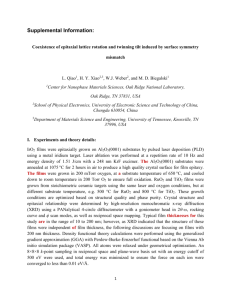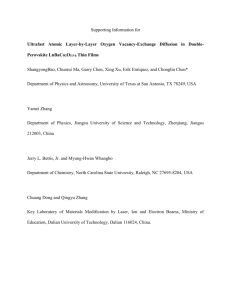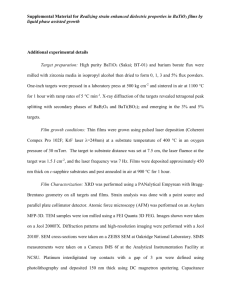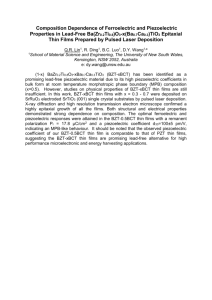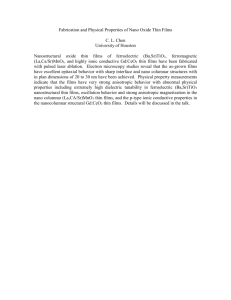Composition Graded, Epitaxial Oxide Nanostructures: Fabrication
advertisement
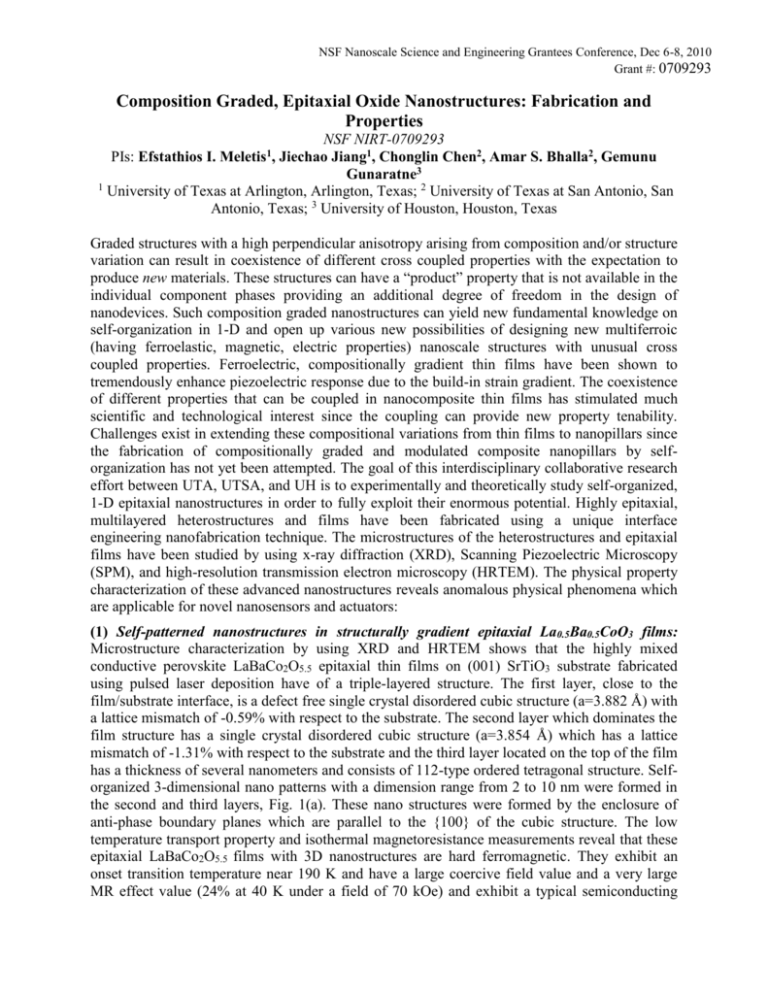
NSF Nanoscale Science and Engineering Grantees Conference, Dec 6-8, 2010
Grant #: 0709293
Composition Graded, Epitaxial Oxide Nanostructures: Fabrication and
Properties
NSF NIRT-0709293
PIs: Efstathios I.
Jiechao Jiang1, Chonglin Chen2, Amar S. Bhalla2, Gemunu
Gunaratne3
1
University of Texas at Arlington, Arlington, Texas; 2 University of Texas at San Antonio, San
Antonio, Texas; 3 University of Houston, Houston, Texas
Meletis1,
Graded structures with a high perpendicular anisotropy arising from composition and/or structure
variation can result in coexistence of different cross coupled properties with the expectation to
produce new materials. These structures can have a “product” property that is not available in the
individual component phases providing an additional degree of freedom in the design of
nanodevices. Such composition graded nanostructures can yield new fundamental knowledge on
self-organization in 1-D and open up various new possibilities of designing new multiferroic
(having ferroelastic, magnetic, electric properties) nanoscale structures with unusual cross
coupled properties. Ferroelectric, compositionally gradient thin films have been shown to
tremendously enhance piezoelectric response due to the build-in strain gradient. The coexistence
of different properties that can be coupled in nanocomposite thin films has stimulated much
scientific and technological interest since the coupling can provide new property tenability.
Challenges exist in extending these compositional variations from thin films to nanopillars since
the fabrication of compositionally graded and modulated composite nanopillars by selforganization has not yet been attempted. The goal of this interdisciplinary collaborative research
effort between UTA, UTSA, and UH is to experimentally and theoretically study self-organized,
1-D epitaxial nanostructures in order to fully exploit their enormous potential. Highly epitaxial,
multilayered heterostructures and films have been fabricated using a unique interface
engineering nanofabrication technique. The microstructures of the heterostructures and epitaxial
films have been studied by using x-ray diffraction (XRD), Scanning Piezoelectric Microscopy
(SPM), and high-resolution transmission electron microscopy (HRTEM). The physical property
characterization of these advanced nanostructures reveals anomalous physical phenomena which
are applicable for novel nanosensors and actuators:
(1) Self-patterned nanostructures in structurally gradient epitaxial La0.5Ba0.5CoO3 films:
Microstructure characterization by using XRD and HRTEM shows that the highly mixed
conductive perovskite LaBaCo2O5.5 epitaxial thin films on (001) SrTiO3 substrate fabricated
using pulsed laser deposition have of a triple-layered structure. The first layer, close to the
film/substrate interface, is a defect free single crystal disordered cubic structure (a=3.882 Å) with
a lattice mismatch of -0.59% with respect to the substrate. The second layer which dominates the
film structure has a single crystal disordered cubic structure (a=3.854 Å) which has a lattice
mismatch of -1.31% with respect to the substrate and the third layer located on the top of the film
has a thickness of several nanometers and consists of 112-type ordered tetragonal structure. Selforganized 3-dimensional nano patterns with a dimension range from 2 to 10 nm were formed in
the second and third layers, Fig. 1(a). These nano structures were formed by the enclosure of
anti-phase boundary planes which are parallel to the {100} of the cubic structure. The low
temperature transport property and isothermal magnetoresistance measurements reveal that these
epitaxial LaBaCo2O5.5 films with 3D nanostructures are hard ferromagnetic. They exhibit an
onset transition temperature near 190 K and have a large coercive field value and a very large
MR effect value (24% at 40 K under a field of 70 kOe) and exhibit a typical semiconducting
NSF Nanoscale Science and Engineering Grantees Conference, Dec 6-8, 2010
Grant #: 0709293
behavior at low temperatures (< 300 K), Fig. 1(b).1,2 The chemical sensitivity of the highly
epitaxial LaBaCo2O5.5 thin films in various oxidized and reducing chemical environments
suggests that the as-grown films can be developed for high temperature chemical sensors, as
highlighted on the cover page of Chemistry of Materials.3
Fig. 1 (a) Plan-view TEM of the LBCO film showing nanopatterning features and (b) temperaturedependent electrical resistance of the film in different magnetic fields and the magnetic-fielddependent MR behavior at different temperatures (inset).
(2) Nano-fingers in epitaxial Mn-doped Ba(Zr,Ti)O3 (Mn:BZT) thin films driven by {110} twin
Boundaries:4 Mn:BZT thin films epitaxially grown on (001) MgO substrate have a pseudocubic perovskite structure and are composed of an epitaxial layer (~150 nm) at the bottom of the
film near the interface and multi-oriented twin-coupled nanofingers at the top of the film, Fig.
2(a). The twin-coupled structures including epitaxial grain and twin domains coexist by sharing,
in addition to the {111}, the {110} planes as the common twin boundary plane, Fig. 2(b). The
joining of the twin-coupled domains on the {110} twin boundary plane is accommodated by
forming a two-dimensional super cell structure (a = 7.02 Å and b = 9.92 Å) on the twin boundary
plane. Evolution from the epitaxial layer to the nanofinger structures is accomplished by
introducing twin boundaries on {111} and {110} planes, Fig. 2(c). In the Mn:BZT, the larger
Zr4+ and Mn2+ atoms could possibly occupy certain positions to form Zr or Mn-rich expanded
(110) and (111) planes which are energetically favorable for forming twin boundaries.
Alternatively, formation of the twin boundaries on {111} and {110} planes along the growth
direction results in the lateral size reduction of the epitaxial grains and eventually leads the
epitaxial grains to be completely transformed into twin-coupled nanofingers. The Mn:BZT films
with such twin-coupled nanofingers have a large tunability of 53.4% at 800 kV/cm, a dielectric
constant value of 180, an extra low dielectric loss of 0.006 at 1 MHz and room temperature, and
a substantially lower dielectric loss value in the 15 to 18GHz range (the loss tangent is only
0.004 at ~17.33 GHz) as compared to those of single layered undoped BZT20 films.
(3) Interface engineered nano fabrication for multilayered ferroelectric heterostructures: The
optimized multilayered ferroelectric BaTiO3/SrTiO35 and BaTiO3/BaZrO36 heterostructures with
various ratios of BaTiO3 and SrTiO3 show unusual microwave dielectric and peiezoelectric
properties. Furthermore, the BaTiO3/SrTiO3 heterostructures on Si show extremely interesting
ferroelectric properties with unusual clamped domain polarization. The ferroelectricity of such
multilayered structures was evident from the hysteresis loop, in which the RT spontaneous
NSF Nanoscale Science and Engineering Grantees Conference, Dec 6-8, 2010
Grant #: 0709293
polarization of ~200.0 C/cm2 and remnant polarization of 100.0 C/cm2 with a coercive field of
10 kV/cm are obtained. These films can be used for super capacitance and energy harvest
applications. The interface engineered nano fabrication technique has been adopted to integrate
ferroelectric thin films and heterostructures directly on metallic substrates. It is surprisingly
found that the as-grown BaTiO3/SrTiO3 heterostructures on metallic tapes have excellent
textured crystalline and highly oriented domain structures. The dielectric and ferroelectric
property studies demonstrated that such multilayered heterostructures exhibit a very high
resistivity value of 1011 cm. Especially, the piezoelectric response was surprisingly found to be
540 x 10-12 C/N, which is about five times higher than the value from the pure BaTiO3 single
crystal and polycrystalline bulk materials [90 – 100 x 10-12 C/N]. Such achievements show that
the multilayered ferroelectric structures can have large piezoelectric response. Thus, they provide
great promise for future applications of new concept advanced device development since the
introduction of multilayered interfaces break the traditional BaTiO3 or SrTiO3 crystal
symmetries, which may result in the recovery of the vacant piezoelectric coefficients.
Fig. 2 (a) X-TEM image of Mn:BZT/Mg; (b) HRTEM showing an epitaxial grain and a twin-coupled
domain joined on (110) and (111) plane; (c) illustration showing reduction of the epitaxial grain size by
forming alternating twin boundaries along the (110) and (111).
References
1
M. Liu, J. Liu, G. Collins, C. R. Ma, C. L. Chen, J. He, J. C. Jiang, E.I. Meletis, A. J. Jacobson and Q. Y. Zhang,
“Magnetic and Transport properties of highly epitaxial (LaBa)CoO
thin films”, Appl. Phys. Let., (in press)
2
J. He, J.C. Jiang, J. Liu, M. Liu, G. Collins, C.R. Ma, C.L. Chen and E. I. Meletis “Self-patterned Nano Structures
in Structurally Gradient Epitaxial La0.5Ba0.5CoO3 Films, Thin Solid Films (submitted).
3
J. Liu, M. Liu, G. Collins, C. L. Chen, X. N. Jiang, W. Q. Gong, A. J. Jacobson, J. He, J. C. Jiang and E. I.
Meletis, “Epitaxial Nature and Transport Properties in Double Perovskite LaBaCo 2O
Thin Films”, Chem. Mat.,
22 (2010) 799[with Artwork in cover page of the special issue of energy research]
4
J. He, J.C. Jiang, E. I. Meletis, M. Liu, J. Liu, G. Collins, C. R. Ma, C. L. Chen and A. Bhalla, “Evolution of Nanofingers in Epitaxial Mn-doped Ba(Zr,Ti)O3 Thin Films Driven by {110} Twin Boundaries” Phil. Mag. Lett.
(submitted).
5
M. Liu, G. Collins, E. Silva, C.R. Ma, J. Liu, C.L. Chen, J. He, J.C. Jiang, E. I. Meletis, S.W. Qu, Q.Y. Zhang and
A. Bhalla, “Interface Engineered Ferroelectric BaTiO3//SrTiO3 Heterostructures (I) with Anomalous Clamped
Polarization on Si (001)”, Journal of Materials Chemistry (submitted).
6
M. Liu, C. R. Ma, G. Collins, J. Liu, C. L. Chen, C. Dai, Y. Lin, L. Shui, H. Wang, J. He, J. C. Jiang, E.I. Meletis,
Q.Y. Zhang and M. W. Cole, “Microwave dielectric properties of Interface Engineered BaTiO 3/SrTiO3
Heterostructures”, Appl. Phys. Lett. (submitted).

